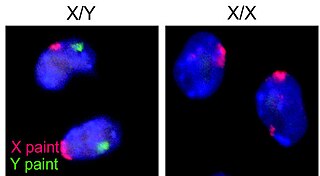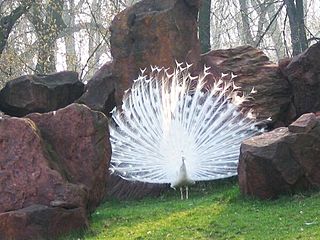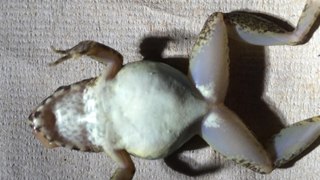 W
WAnimal sexual behaviour takes many different forms, including within the same species. Common mating or reproductively motivated systems include monogamy, polygyny, polyandry, polygamy and promiscuity. Other sexual behaviour may be reproductively motivated or non-reproductively motivated.
 W
WArrhenotoky, also known as arrhenotokous parthenogenesis, is a form of parthenogenesis in which unfertilized eggs develop into males. In most cases, parthenogenesis produces exclusively female offspring, hence the distinction.
 W
WIncubation is the process by which certain oviparous (egg-laying) animals hatch their eggs; it also refers to the development of the embryo within the egg under favorable environmental condition. Multiple and various factors are vital to the incubation of various species of animal. In many species of reptile for example, no fixed temperature is necessary, but the actual temperature determines the sex ratio of the offspring. In birds in contrast, the sex of offspring is genetically determined, but in many species a constant and particular temperature is necessary for successful incubation. Especially in poultry, the act of sitting on eggs to incubate them is called brooding. The action or behavioral tendency to sit on a clutch of eggs is also called broodiness, and most egg-laying breeds of poultry have had this behavior selectively bred out of them to increase production.
 W
WEgg tossing or egg destruction is a behavior observed in some species of birds where one individual removes an egg from the communal nest. This is related to infanticide, where parents kill their own or other's offspring. Egg tossing is observed in avian species, most commonly females, who are involved with cooperative breeding or brood parasitism. Among colonial non-co-nesting birds, egg-tossing is observed to be performed by an individual of the same species, and in the case of brood parasites this behavior is done by either the same or different species. The behavior of egg tossing offers its advantages and disadvantages to both the actor and recipient.
 W
WEpitoky is a process that occurs in many species of polychaete marine worms wherein a sexually immature worm is modified or transformed into a sexually mature worm. Epitokes are pelagic morphs capable of sexual reproduction. Unlike the immature form, which is typically benthic, epitokes are specialized for swimming as well as reproducing. The primary benefit to epitoky is increased chances of finding other members of the same species for reproduction.
 W
WInternal fertilization is the union of an egg cell with a sperm during sexual reproduction inside the female body. Internal fertilization, unlike its counterpart, external fertilization, brings more control to the female with reproduction. For internal fertilization to happen there needs to be a method for the male to introduce the sperm into the female's reproductive tract. In mammals, reptiles, some birds, some fish and certain other groups of animals, this is done by copulation, the penis or other intromittent organ being introduced into the vagina or cloaca. In most birds, the cloacal kiss is used, the two animals pressing their cloacas together while transferring sperm. Salamanders, spiders, some insects and some molluscs undertake internal fertilization by transferring a spermatophore, a bundle of sperm, from the male to the female. Following fertilization, the embryos are laid as eggs in oviparous organisms, or in viviparous organisms, continue to develop inside the reproductive tract of the mother to be born later as live young.
 W
WKoinophilia is an evolutionary hypothesis proposing that during sexual selection, animals preferentially seek mates with a minimum of unusual or mutant features, including functionality, appearance and behavior. Koinophilia intends to explain the clustering of sexual organisms into species and other issues described by Darwin's Dilemma. The term derives from the Greek, koinos, "common", "that which is shared", and philia, "fondness".
 W
WA lek is an aggregation of male animals gathered to engage in competitive displays and courtship rituals, known as lekking, to entice visiting females which are surveying prospective partners to mate with. A lek can also indicate an available plot of space able to be utilized by displaying males to defend their own share of territory for the breeding season. A lekking species is characterised by male displays, strong female mate choice, and the conferring of indirect benefits to males and reduced costs to females. Although most prevalent among birds such as black grouse, lekking is also found in a wide range of vertebrates including some bony fish, amphibians, reptiles, and mammals, and arthropods including crustaceans and insects.
 W
WThe lek paradox is the conundrum of how additive or beneficial genetic variation is maintained in lek mating species, in the face of consistent female preferences, sexual selection. While many studies have attempted to explain how the lek paradox fits into Darwinian theory, the paradox remains. Persistent female choice for particular male trait values should erode genetic diversity in male traits and thereby remove the benefits of choice, yet choice persists. This paradox can be somewhat alleviated by the occurrence of mutations introducing potential differences, as well as the possibility that traits of interest have more or less favorable recessive alleles.
 W
WMaternal recognition of pregnancy is a crucial aspect of carrying a pregnancy to full term. Without maternal recognition to maintain pregnancy, the initial messengers which stop luteolysis and promote foetal implantation, growth and uterine development finish with nothing to replace them and the pregnancy is lost.
 W
WIn biology, mating is the pairing of either opposite-sex or hermaphroditic organisms, usually for the purposes of sexual reproduction. Some definitions limit the term to pairing between animals, while other definitions extend the term to mating in plants and fungi. Fertilization is the fusion of two gametes. Copulation is the union of the sex organs of two sexually reproducing animals for insemination and subsequent internal fertilization. Mating may also lead to external fertilization, as seen in amphibians, fishes and plants. For the majority of species, mating is between two individuals of opposite sexes. However, for some hermaphroditic species, copulation is not required because the parent organism is capable of self-fertilization (autogamy); for example, banana slugs.
 W
WMilt is the seminal fluid of fish, mollusks, and certain other water-dwelling animals which reproduce by spraying this fluid, which contains the sperm, onto roe. It can also refer to the sperm sacs or testes that contain the semen.
 W
WOvoviviparity, ovovivipary, ovivipary, or aplacental viviparity is an outmoded term used as a "bridging" form of reproduction between egg-laying oviparous and live-bearing viviparous reproduction. Ovoviviparous animals have the embryos develop inside eggs that remain in the mother's body until they are ready to hatch.
 W
WParental investment, in evolutionary biology and evolutionary psychology, is any parental expenditure that benefits offspring. Parental investment may be performed by both males and females, females alone or males alone. Care can be provided at any stage of the offspring's life, from pre-natal to post-natal.
 W
WIn behavioral ecology, polyandry is a class of mating system where one female mates with several males in a breeding season. Polyandry is often compared to the polygyny system based on the cost and benefits incurred by members of each sex. Polygyny is where one male mates with several females in a breeding season . A common example of polyandrous mating can be found in the field cricket of the invertebrate order Orthoptera. Polyandrous behavior is also prominent in many other insect species, including the red flour beetle and the species of spider Stegodyphus lineatus. Polyandry also occurs in some primates such as marmosets, mammal groups, the marsupial genus' Antechinus and bandicoots, around 1% of all bird species, such as jacanas and dunnocks, insects such as honeybees, and fish such as pipefish.
 W
WReproductive suppression involves the prevention or inhibition of reproduction in otherwise healthy adult individuals. It includes delayed sexual maturation (puberty) or inhibition of sexual receptivity, facultatively increased interbirth interval through delayed or inhibited ovulation or spontaneous or induced abortion, abandonment of immature and dependent offspring, mate guarding, selective destruction and worker policing of eggs in some eusocial insects or cooperatively breeding birds, and infanticide, and infanticide in carnivores) of the offspring of subordinate females either by directly killing by dominant females or males in mammals or indirectly through the withholding of assistance with infant care in marmosets and some carnivores. The Reproductive Suppression Model argues that "females can optimize their lifetime reproductive success by suppressing reproduction when future [physical or social] conditions for the survival of offspring are likely to be greatly improved over present ones". When intragroup competition is high it may be beneficial to suppress the reproduction of others, and for subordinate females to suppress their own reproduction until a later time when social competition is reduced. This leads to reproductive skew within a social group, with some individuals having more offspring than others. The cost of reproductive suppression to the individual is lowest at the earliest stages of a reproductive event and reproductive suppression is often easiest to induce at the pre-ovulatory or earliest stages of pregnancy in mammals, and greatest after a birth. Therefore, neuroendocrine cues for assessing reproductive success should evolve to be reliable at early stages in the ovulatory cycle. Reproductive suppression occurs in its most extreme form in eusocial insects such as termites, hornets and bees and the mammalian naked mole rat which depend on a complex division of labor within the group for survival and in which specific genes, epigenetics and other factors are known to determine whether individuals will permanently be unable to breed or able to reach reproductive maturity under particular social conditions, and cooperatively breeding fish, birds and mammals in which a breeding pair depends on helpers whose reproduction is suppressed for the survival of their own offspring. In eusocial and cooperatively breeding animals most non-reproducing helpers engage in kin selection, enhancing their own inclusive fitness by ensuring the survival of offspring they are closely related to. Wolf packs suppress subordinate breeding.
 W
WSpawn is the eggs and sperm released or deposited into water by aquatic animals. As a verb, to spawn refers to the process of releasing the eggs and sperm, and the act of both sexes is called spawning. Most aquatic animals, except for aquatic mammals and reptiles, reproduce through the process of spawning.
 W
WStatoblasts are a means to reproduce asexually by a method that is unique among bryozoans and enables a colony's lineage to survive the variable and uncertain conditions of freshwater environments. Statoblasts are masses of cells that function as "survival pods" rather like the gemmules of sponges. Statoblasts form on the funiculus (cord) connected to the parent's gut, which nourishes them. As they grow, statoblasts develop protective bivalve-like shells made of chitin. When they mature, some types stick to the parent colony, some fall to the bottom, some contain air spaces that enable them to float, and some remain in the parent's cystid to re-build the colony if it dies. Statoblasts can remain dormant for considerable periods, and while dormant can survive harsh conditions such as freezing and desiccation. They can be transported across long distances by animals, floating vegetation, currents and winds. When conditions improve, the valves of the shell separate and the cells inside develop into a zooid that tries to form a new colony. A study estimated that one group of colonies in a patch 1 square meter (11 sq ft) produced 800,000 statoblasts.
 W
WTrematodes are parasitic flatworms of the class Trematoda, specifically parasitic flukes with two suckers: one ventral and the other oral. Trematodes are covered by a tegument, that protects the organism from the environment by providing secretory and absorptive functions.
 W
WAmong animals, viviparity is development of the embryo inside the body of the parent, eventually leading to live birth. This is opposed to oviparity which is a reproductive mode in which females lay developing eggs that complete their development and hatch externally from the mother.